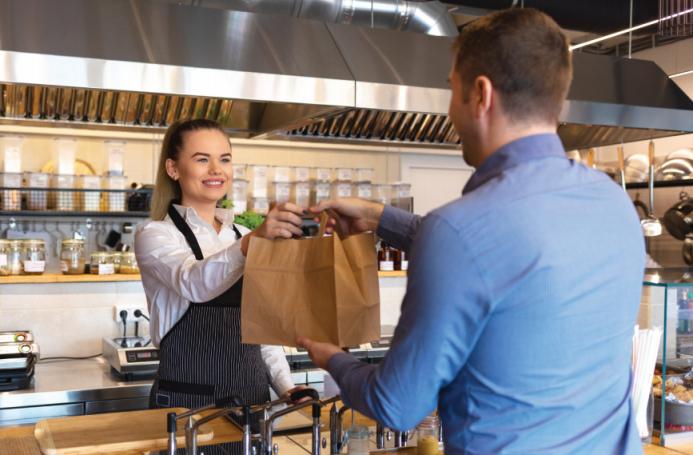The UK’s takeaway market is one of the very few foodservice outlet channels still managing to operate during the coronavirus pandemic, with a large number continuing to deliver. Helena Drakakis gives an overview of the sector and explores the trends and opportunities it brings.
The takeaway sector has experienced unprecedented change, with 849 million meals delivered to homes in 2019. Fuelled by greater convenience, better technology and a wider variety of cuisines, it is an ever evolving market.
Trends
Takeaways have come a long way from the traditional Indian or Chinese. Helped by delivery platforms such as Deliveroo and Just Eat, it is now possible to source a far wider variety of takeaway meals.
Research company Mintel estimates that 37% of consumers are ordering home delivery more often from burger and chicken outlets, for example, with more affluent diners tapping into a premium market.
“An improvement in the animal welfare of chickens is helping to attract a more affluent clientele to chicken restaurants and outlets, with chicken meals typically costing more than other fast food choices,” says senior foodservice analyst Trish Caddy.
Healthier options are also a rising category, with consumers willing to pay more for weekday lunchtime and evening meals.
Premium potato product supplier Aviko suggests replacing traditional chips with sweet potato fries, for example, or introducing more meat-free options to tap into a rising vegan, vegetarian or flexitarian population.
According to the British Takeaway Campaign, vegan orders increased by 388% between 2016 to 2018, alongside other flavour profiles. These include Persian food, which has seen grown 34% in the same time, while the number of Nepalese takeaway restaurants has increased by 16%.
Speed of service
Takeaway operators and chefs are notoriously busy, so by giving customers greater speed of service online or in depot will enhance any offer.
National wholesaler JJ Foodservice has improved its website and online ordering capability so customers can order in advance and collect quickly.
In the past 12 months alone, the number of cashless customers ordering and paying online has doubled from 3,000 to 6,000 per week.
“People who pay online in advance can be in and out of a branch in just minutes.
For delivery customers, drivers can be off the premises much faster,” says JJ’s chief operating officer, Mushtaque Ahmed.
An improved online search feature also makes it easier to find special offers and to search by brand, case size and origin.
Customers can also search specific subcategories such as vegan, MSC – the mark of sustainable seafood – and sugar-free.
- Takeaway orders placed with mobile phones rise by 69%
“Moving customers online has helped us to improve efficiency and reduce costs, therefore enabling us to keep passing on great savings to caterers,” said Mick Dudley, JJ’s chief technology officer.
Another way to enhance service to takeaway operators is for depot staff to give a personal service to regular customers, highlighting offers on items they routinely buy or reminding them of goods they may have forgotten.
Charlie Miller, who runs Miller Catering in London, says: “I might not be a wholesaler’s biggest customer, but I want great customer service and staff who understand my business. I don’t always have time to read the promotional leaflets, so I rely on staff to let me know what special offers are relevant to me.”
Eco-friendly packaging
Alongside plant-based food increasing in popularity, consumers are also looking for outlets using eco-friendly packaging. While the BBC’s Blue Planet II series sparked the removal of plastic straws from many businesses, consumers now want reassurance that containers, cutlery, coffee cups and bags meet high environmental standards.
This year, waste charity WRAP published comprehensive guidance for businesses to navigate the complex world of plastic packaging, highlighting the need for clear labelling about what is recyclable as crucial for consumers.

Takeaways
Meanwhile, compostable catering disposable company Vegware says that while outlets must consider the environment, operators must also choose packaging that showcases food and drink offerings. “Keep in mind the quality, style, practicality and functionality of your packaging,” says Vegware’s brand communications officer, Aarti Arora-McLean.
The global company has a portfolio of more than 300 plant-based compostable foodservice products and has seen a 53% increase in sales in one year, from £20m in 2017-2018 to £30.7m the following year.
“Demand for Vegware’s disposables has increased exponentially. We believe it’s due to raised awareness on the challenges of recycling conventional plastic packaging used in foodservice.
“The goal with eco-friendly packaging is to join a circular economy and improve your business’ environmental footprint. Consider both how the packaging is manufactured – what materials are being used and your supplier’s supply chain – and what your options are for disposal,” he adds.
- Read more Foodservice Focus








